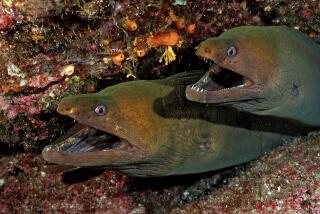Eagle in Newport Is From Catalina
- Share via
Some nature enthusiasts got a rare treat over the weekend when they spotted a bald eagle in Upper Newport Bay.
The male eagle had a tag reading “K13,” according to Newport Beach animal control officers who saw the large bird through binoculars at dusk Saturday, said Sgt. Mark Everton, a city police spokesman.
“We think it’s an escapee from Catalina Island, because animal control ran the number on their computers and it turned out to be from a place on Catalina,” Everton said.
David Garcelon, president of the Institute for Wildlife Studies in Arcata, which is managing the eagle program on Santa Catalina and other channel islands, confirmed that the eagle was released in 2001.
“We’ve been getting calls from people in Newport about this bird. It’s pretty exciting,” Garcelon said.
K13 has apparently been an active bird, with sightings reported again on Catalina in between Newport sightings, Garcelon said.
“This bird doesn’t have a mate yet, but it can come over to the island and back. We have no control over them,” he said.
Males are smaller than females and weigh 8 to 9 pounds. It’s the adults, age 5 and older, that have the regal-looking light-colored feathers on the tail and head. Younger eagles are brown, he said.
In 1980, various agencies began a program to reintroduce bald eagles to the island.
The eagles, once found in greater numbers in Southern California and the Channel Islands, have all but disappeared from the region. The reasons are not completely understood, but the likely cause was use of the industrial pesticide DDT, Garcelon said.
Other birds and fish make up the diet for the predator. But Garcelon said that DDE, a metabolized form of DDT, causes thinness in eagle eggs, making them break easily during nesting.
When the eagles mate on Catalina, the eggs are removed and shipped to San Francisco, where they’re incubated at the San Francisco Zoo.
The hatchlings are returned to the island within 10 days. At eight weeks, they’re put in towers around the island and usually start to fly at 12 weeks, Garcelon said.
“They usually stay on the island but sometimes go and leave and sometimes go for good,” he said, adding that the island has about five breeding pairs.


